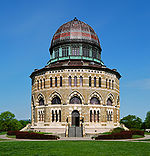WRUC

WRUC (89.7 MHz) is an independent educational college radio station, owned and operated by Union College in Schenectady, New York. The station transmits with an effective radiated power of 100 watts, providing coverage over an approximate 15-mile (25 kilometer) radius. WRUC also streams its programming on Internet radio. The station's offices and studios are located in the Reamer Campus Center on the Union College campus. WRUC's slogan is "The First Station In The Nation". The station traces its history back to October 14, 1920, the date an amateur station located at Union College first began making regular broadcasts. However, WRUC's priority claim is not widely accepted. There are continuity issues, because, after the demise of Union's broadcasting station, WRL, in 1924, the college did not resume any broadcasting activities until 1941. In addition, there are several stations that claim even longer histories.
Excerpt from the Wikipedia article WRUC (License: CC BY-SA 3.0, Authors, Images).WRUC
Van Vranken Avenue, City of Schenectady
Geographical coordinates (GPS) Address Nearby Places Show on map
Geographical coordinates (GPS)
| Latitude | Longitude |
|---|---|
| N 42.818 ° | E -73.929 ° |
Address
Union College
Van Vranken Avenue
12308 City of Schenectady
New York, United States
Open on Google Maps







